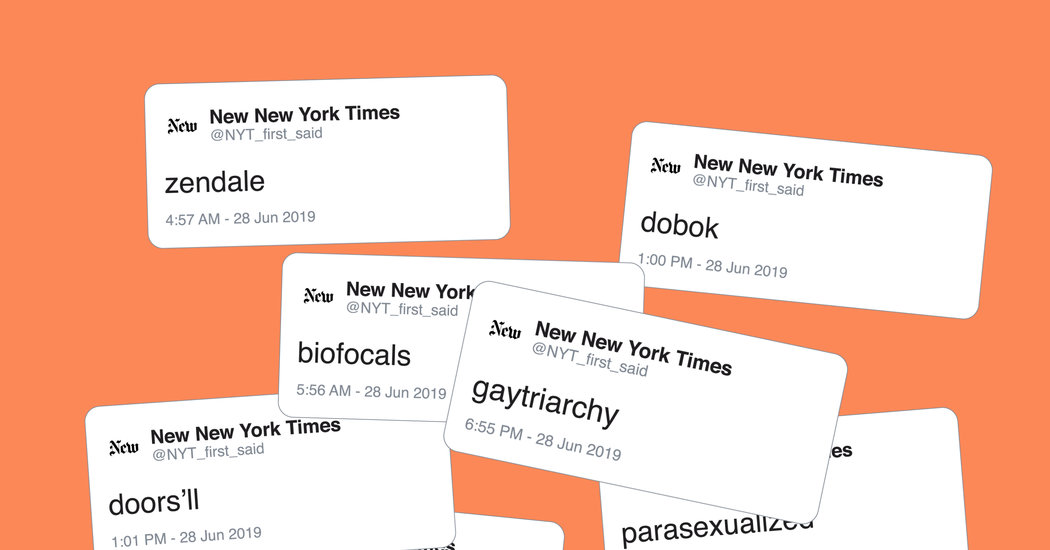
Times Insider explains who we are and what we do, and delivers behind-the-scenes insights into how our journalism comes together.
The most popular tweet from @NYT_first_said, a Twitter bot that since 2017 has tracked new words in The New York Times, has received 8,500 retweets and 28,500 likes. It comes from a phrase used by President Trump in January 2018 to characterize countries like Haiti and some nations in Africa.
“This is your day to go viral,” Brianna Wu, a software engineer and current congressional candidate, tweeted at the bot in response. “You earned it.”
Technically, there is no “you” for the account. The bot is a computer program that scrapes The Times’s website hourly for new articles and compares them against a memory bank of words the paper has previously used. The bot then tweets the words that appear to be new. On a typical day, it posts a handful of tweets, comprising neologisms, scientific terms, words in foreign languages and the occasional typo.
On June 28, its tweets read: zendale, zombiecorn, biofocals, parasexualized, dobok, doors’ll, gaytriarchy. (That last one was by far the most popular.)
There is, however, a person behind the account: Max Bittker, a 24-year-old Google software engineer who built the program. “I’m most interested in uses of programming that are weird or interesting or artistic,” Mr. Bittker said in a recent telephone interview. “One of them is Twitter bots, but also data visualization for journalism, text analysis and that kind of thing.”
Mr. Bittker built the first version of the program in a weekend or two, he said, helped substantially by open-source code for a project called NewsDiffs, which records changes to online news articles. It was built by three coders, including the former New York Times journalist Jennifer 8. Lee, who made the source code available to other engineers. That allowed Mr. Bittker to create a “fork,” or new project, off the same framework.
The initial draft was followed by a long period of refinement, to “filter out things that were not interesting,” Mr. Bittker said. “It would tweet every URL and proper nouns and things like that.” These days, a number of heuristics limit what the bot will tweet: no capital letters, dashes, underscores or @ symbols.
To date, @NYT_first_said has tracked more than 13,000 first appearances in The Times. Many of the most popular ones have come when The Times has used colorful slang — like “thiccc,” “hypebeasts” and “shooketh.”
Words related to social trends tend to find success on the account, particularly those that mirror social media itself. The bot’s followers have gone wild, for example, for verminfluencers, kidfluencers, fitfluencers and small-time influencers of both the micro- and nano- varieties.
Ranked by popularity, the Times music reporter Joe Coscarelli’s use of “deadass” came second only to the presidential profanity, with 4,500 retweets and 16,000 favorites.
“‘Deadass’ is the perfect ‘NYT First’ because it’s quintessential New York slang that has transcended thanks to the geographical flattening facilitated by the internet,” Mr. Coscarelli wrote in an email. “It lets people feel like they’re part of an edgy insider’s club but is also mainstream enough to be widely relatable.”
(Mr. Coscarelli also wished to credit the pop star Billie Eilish, the subject of the article in which the word appeared. He described her as “a teenager who uses ‘deadass’ way more than I do and is responsible for this virality and basically all virality.”)
The account’s followers tend to take special pleasure when it records a “naughty” word, Mr. Bittker said, likely because of the contrast it strikes with The Times’s buttoned-up reputation. That “Old Gray Lady” image is also why he chose The Times, rather than another publication, for the project.
“There’s a lot of scatological things that will be popular, and they’re never my favorites, because I don’t want it to just be a swear bot that’s funny because it swears,” Mr. Bittker said. His own tastes run to the scientific: “I really love when it’s the name of some dinosaur or mega-bird.”
Mr. Bittker also speculated that a sense of cultural celebration drove the popularity of many of the bot’s tweets. Words relating to food and L.G.B.T.Q. issues, for instance, tend to do well. “When some cuisine or dish is passing into the mainstream American consciousness and having its moment, people really like to celebrate that,” he said.
Similarly, when it comes to words relating to gender and sexuality, The Times’s first use can represent a breakthrough in representation, even if in a small way. “Maybe that’s a thawing-over of what kind of subcultures are fit to be canonized or to be covered,” he suggested.
Mr. Bittker said the bot has had one happy side effect for him personally: Since each of the bot’s tweets is followed by the article in which the word appeared, the account has functioned as an alternative algorithm for Times stories, leading him to journalism beyond the home screen that he might not have otherwise discovered.
There’s just one thing left to hope.
“I’ve kind of had this dream that the bot will eventually get to tweet its own name,” he said, adding that he personally refers to the project with no dashes, symbols, underscores or uppercase letters: nytfirstsaid.
Follow the @ReaderCenter on Twitter for more coverage highlighting your perspectives and experiences and for insight into how we work.







